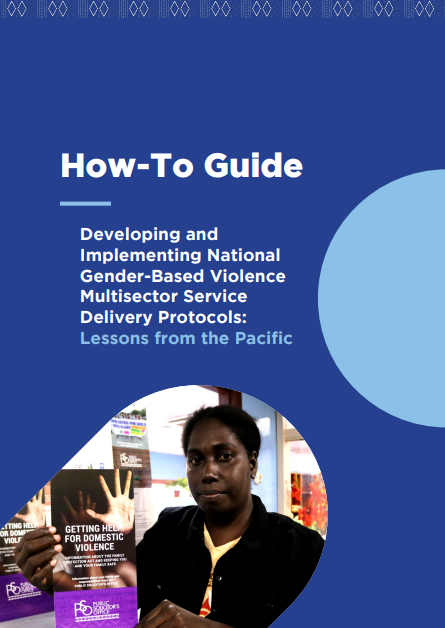
How-To Guide: Developing and Implementing National GBV Multisector Service Delivery Protocols: Lessons from the Pacific

The provision, coordination and governance of essential, multisector health, police, justice, and social services can significantly mitigate the consequences that violence has on the well-being, health and safety of women and girls’ lives, assist in the recovery and empowerment of women, and stop violence from reoccurring. One key component of developing coordinated, multisector care, at national and local levels, is to develop standard procedures that guide how key service providers work together to respond to cases of gender-based violence (GBV) and support survivors in their help-seeking journey.
These standard procedures – known in the Pacific region as ‘Service Delivery Protocols’ or ‘Interagency Guidelines’ – are designed to ensure that services of all sectors are coordinated and governed to respond in a comprehensive way, are women-centred and, where necessary, child-centred, and are accountable to survivors and to each other.
Drawing on the diverse experiences across five Pacific Island countries -Fiji, Kiribati, Samoa, Solomon Islands and Tonga - this How-To Guide provides relevant background information and guidance on the step-by-step process of developing national multisector service delivery protocols and localised referral pathways.
This layout of the process of developing national protocols, referral pathways (which can be adapted for both emergency and non-emergency contexts) to strengthen violence against women and girls (VAWG) response through cross-sectoral and multi-stakeholder collaboration, and with engagement of GBV service providers, civil society organisations and national governments.
Intended as practical, Pacific-specific guidelines, aligned with international and regional best practice, this How-To Guide aims to support learning for Pacific Island governments, civil society, and development partners on how to strengthen essential service delivery and coordination for survivors of GBV.
It is the second paper to be released in 2022 as part of a series of knowledge products led by UN Women under the Pacific Partnership to End Violence Against Women and Girls (Pacific Partnership) programme, in partnership with government and civil society organisations. The programme is funded primarily by the European Union, and the Governments of Australia and New Zealand, and UN Women, and is led by the Pacific Community, UN Women, and the Pacific Islands Forum Secretariat.
You can also read an accessible version in Word below.